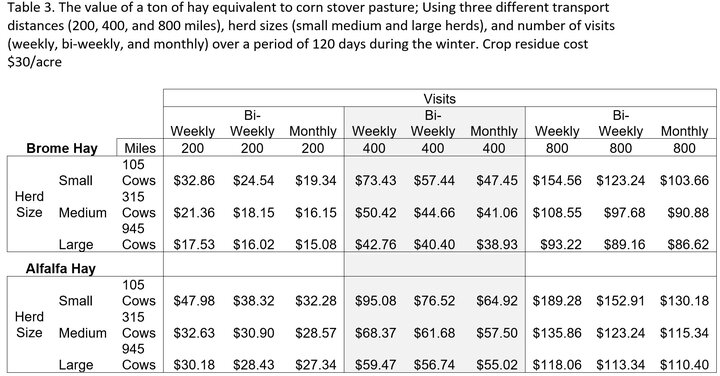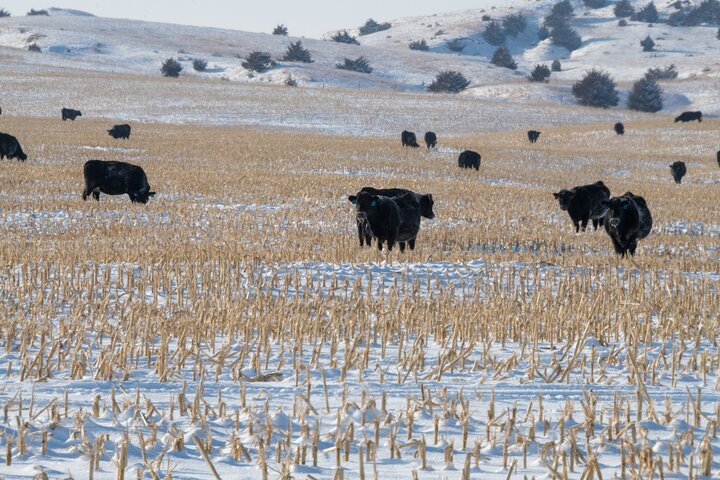There are times feed in the local area is scarce or expensive. This may happen during a time of drought or other natural or manmade disaster. With the help of UNL’s modified Feed Cost Cow-Q-Later it was straightforward to make some comparisons among methods of feeding cows and with some additional information estimate comparison costs among feed sources, including transporting cows. With the current drought conditions in many parts of the Western US, we felt it was worth the effort to develop the tool and provide some commentary on what we found about those costs. Using this tool, we made a comparison between two types of hay and moving cattle to an inexpensive feed source such as corn stover, what many people in Nebraska refer to as grazing corn stalks. During the late fall and winter, corn fields in Nebraska have been harvested and lie idle with leftover crop residue. This material has been found to be a fair beef cow feed. Nebraska is fortunate in that most years the fields don’t freeze over with ice covering the feed and the snowfall is sparse enough that cattle have access to the corn stalks, leaves, cobs and leftover husks for the whole winter grazing season. Depending on a cow’s stage of pregnancy or lactation, and the available parts of the corn crop residue, this feed can work well. Since the stalks are unharvested and little labor is required, this can often be an inexpensive way to winter beef cows, especially if transporting cows to and from the grazing area and monitoring them comes at a reasonable cost. Table 1 shows the values used in the base scenario where hay is priced at values that are equivalent to transporting cows 200 miles and making eighteen managerial visits (approximately once a week). This table contains the same information used the Cornstalk Grazing Cow-Q-Lator (CSGC), downloadable at https://farmcents.unl.edu/ag-manager-tools . This Cow-Q-Lator when released will be easily accessed through the same FarmCents website, UNL Beef and CAP websites. FYI the CSGC is also included as one of the excel worksheets (tabs) in the Feed Cost Cow-Q-Lator (FCC) available at the same sites. The CSGC converts corn yields into available dry matter (DM) using research done by animal scientists at UNL.

This available DM is then converted into animal units per month (AUM’s), which is an estimate of the needed DM for a thousand-pound cow for a month. Using this information, the CSGC provides information as to the number of acres needed, which must be then entered by the user as rented acres. This is critical to do so that cost will accurately be represented in the final outcome. It is important to remember that the user specifies the expected number of acres needed, the number of cows and number of days animals will be grazed. In addition, the CSGC estimates the transportation and management cost and derives per unit costs of feed consumed by the animal ($/lb.) for crude protein (CP), total digestible nutrients (TDN) and DM based on user provided information. The remainder of the needed information used in the base scenario factors are listed in Table 1.
The FCC calculates a similar value for individual feeds, which in this instance are brome and alfalfa hay’s, listed in Table 2. Note the feeding cost includes all of the factors related to feeding each type of feed, e.g. both loss and costs of transportation, storage, feeding. Feed properties such as DM, CP and TDN content can play a significant role in determining costs. This Table has the base scenario values that result in the same cost of DM on a per pound basis, as the base scenario information for cornstalks. That costs $0.0475/lb. of DM.

Since this question is somewhat involved, we have created an additional feature to the Feed Cost Cow-Q-Lator that provides a way to estimate the breakeven cost of hay verses the transportation and care of cows on corn crop residue. This new Cow-Q-Lator be released soon will be called the Cow Transportation Cow-Q-Lator (CTC) it will be available for downloading at the Farmcents website under the AgManagers Tools tab, https://farmcents.unl.edu/ag-manager-tools . Using a version of the CTC we have constructed a sensitivity table, Table 3. This table provides a starting point in determining what the costs would be to transport cows for the winter verses feeding them by some other method, in this case brome or alfalfa hay. To remind us what we are talking about, our analysis is limited to two alternative hay types, three herd sizes, 105, 315, and 935 head, three different care scenarios, weekly, bi-weekly and monthly visits and three distances, 200, 400 and 800 miles to cornstalk pastures. The estimated hay values will change with different quality characteristics of hay, labor costs to feed and the amount of expected waste. From Table 3 it is evident that for all herd sizes and care regimes have a lower cost associated with the transport of cows to corn residue. At the time of the writing of this report brome hay was priced at $190/ton and alfalfa $210/ton.

Brome hay would have to fall nearly $35/ton to $154.56/ton in order to breakeven for the small herd, transported eight hundred miles with weekly visits, Table 3. When brome hay is more than $154.56/ton it is more economical to transport cows eight hundred miles to winter them for four months on corn stalks. As with all analysis, certain assumptions have been made and it is important to understand what those are and whether you agree with them. Remember there may be factors related to corn residue grazing that may pose additional costs or risk and are not accounted for in this analysis. These include: a higher likelihood that an animal could be lost or disappear, weather conditions are not usually stable during the winter e.g., winter storm’s effect on cows. Also there have historically been times when fields freeze over and cows must be supplemented with hay, this may be a short or long period depending on the storm. Individuals must evaluate the situation for themselves and make decisions about these costs in their decision-making process. There are other perspectives when looking at and quantifying the decision to transport cattle or supplement feed them. If the current value of brome hay really is $190/ton and the rental rate for an acre of corn stalks $30/acre and are transported eight hundred miles with weekly visits planned a small herd would break even if the crop residue price rose to $75.60/acre. The economic impact of high forage costs in the event of a drought often comes down to choosing among costly alternatives. In the last case where the choice between feeding hay that cost $190/ton or corn stover at $76.50/acre the cost of feeding one cow for those 4 months is estimated to be $545.32/hd. That is expensive and would mean the production of a 500 lb. calf sold at $160/cwt, $800/hd., leaves only $254.68/cow cost to break even for the year. This value is very unlikely to be enough to feed the cow the rest of the year, resulting in a loss. The savings from grazing the $30 corn stalks would amount to $86.86/cow, or feed costs of $458.46/cow. This would leave a total of $341.54/cow costs for the remainder of the production cycle. The question becomes one of not just which is less expensive to feed, but more of a production cost issue. If cost are this high other alternatives may be more viable and should be considered. Looking at the cost of corn stalk grazing when the transportation miles are cut in half to 400 miles, cow cost drop dramatically, by nearly $200/cow to $259.50/cow. This reduction is in-line with brome hay cost of $73.43/ton and leaves an estimated $540.50/cow cost for the remainder of the season. What is interesting about the analysis done here is that it shows that transporting a large number of cows, is much more economical than sending smaller numbers. This is especially true when more frequent managerial visits come into play. This brings up an interesting point. Could producers ban together and take advantage of the economies of numbers? If they could do so it seems there is a great deal of savings to be had. Going back to the example we just used where cow costs were $545.32/hd., banning together as a group could potentially reduce cost by $237.21/hd. to $308.11/hd. This is more than a 43% reduction in cost which is much the same idea as banning together for branding or moving cattle. Ultimately it isn’t any one decision that breaks the bank, it is usually a series of choices. Therefore, it is important to minimize decisions that are costly and take time to think outside the box and analyze things as closely as possible, hopefully resulting in the best results as possible.
For more information on the Cornstalk Grazing Cow-Q-Lator contact your local Beef Extension Educator. The Feed Cost Cow-Q-Lator can be found at https://extension.unl.edu/statewide/westcentral/ag-economics/
Interviews with the authors of BeefWatch newsletter articles become available throughout the month of publication and are accessible at https://go.unl.edu/podcast.
Topics covered:
Forage crop systems, Crop residues, Marketing, budgets & management, Budgets & cost of production

